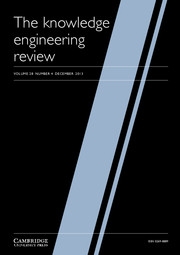Article contents
Towards a diagrammatic classification
Published online by Cambridge University Press: 24 July 2013
Abstract
In this article I present and discuss some criteria to provide a diagrammatic classification. Such a classification is of use for exploring in detail the domain of diagrammatic reasoning. Diagrams can be classified in terms of the use we make of them—static or dynamic—and of the correspondence between their space and the space of the data they are intended to represent. The investigation is not guided by the opposition visual vs. non-visual, but by the idea that there is a continuous interaction between diagrams and language. Diagrammatic reasoning is characterized by a duality, since it refers both to an object, the diagram, having its spatial characteristics, and to a subject, the user, who interprets them. A particular place in the classification is occupied by constructional diagrams, which exhibit for the user instructions for the application of some procedures.
Information
- Type
- Articles
- Information
- The Knowledge Engineering Review , Volume 28 , Special Issue 3: Visualization, Visual Representation and Reasoning , September 2013 , pp. 237 - 248
- Copyright
- Copyright © Cambridge University Press 2013
References
- 5
- Cited by

